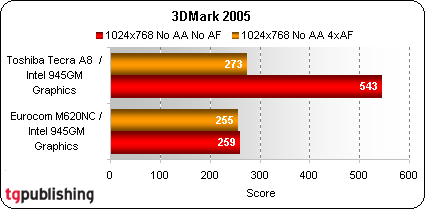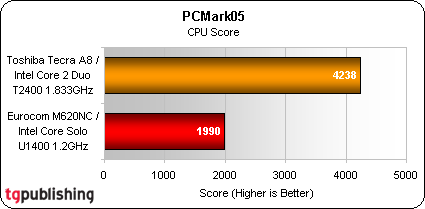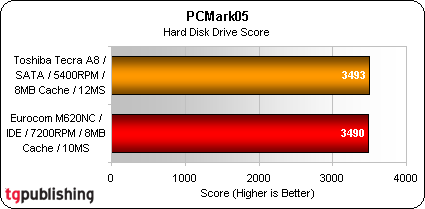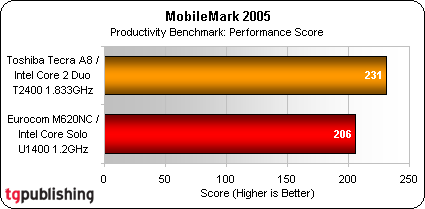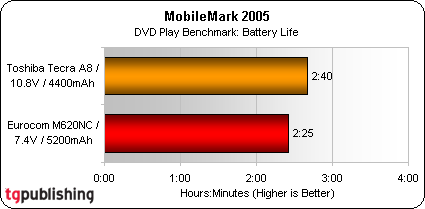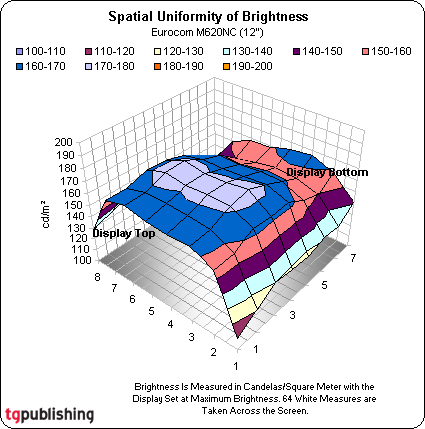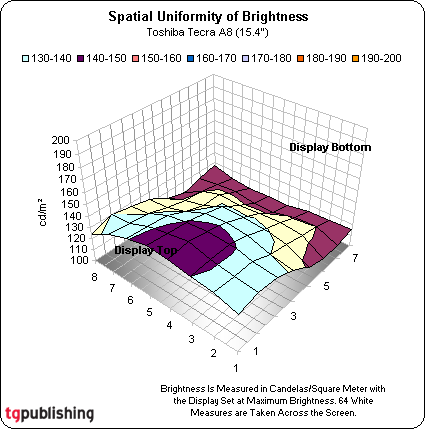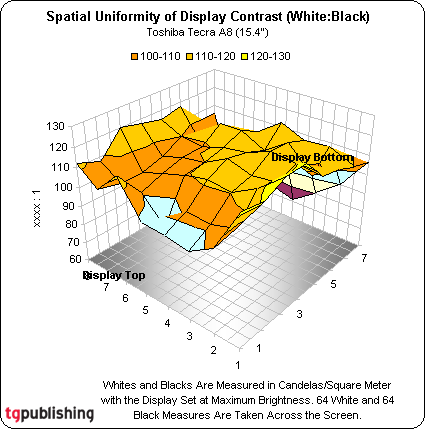EUROCOM M620NC Titanium: Performance
In comparison to the Tecra A8 the Eurocom M620NC Titanium's No AA No AF score doesn't look so hot. Though these two notebooks have the same integrated Intel graphics controller, the two have different CPUs. The M620NC Titanium as tested only has an Intel
In comparison to the Tecra A8 the Eurocom M620NC Titanium’s No AA No AF score doesn’t look so hot. Though these two notebooks have the same integrated Intel graphics controller, the two have different CPUs. The M620NC Titanium as tested only has an Intel
In this slide it is obvious the difference a faster Intel Core Duo makes over a slower Intel Core Solo.
In this slide it is obvious the difference a faster Intel Core Duo makes over a slower Intel Core Solo.
Most of the difference here is explained by FSB speeds. Eurocom's FSB is 533 MHz; the Toshiba's is 667 MHz.
Most of the difference here is explained by FSB speeds. Eurocom’s FSB is 533 MHz ; the Toshiba’s is 667 MHz.
The Hitachi Travelstar hard drive in the Eurocom runs at 7200 RPM so you'd expect it offer better performance than the Tecra's Fujitsu 5400 RPM drive. The difference? It could well come down to differences in performance between the SATA and IDE interface
The Hitachi Travelstar hard drive in the Eurocom runs at 7200 RPM so you’d expect it offer better performance than the Tecra’s Fujitsu 5400 RPM drive. The difference ? It could well come down to differences in performance between the SATA and IDE interface
The M620NC scores well in this benchmark even though it only includes one ultra low voltage core. It's performance is typical of notebooks with this CPU.
The M620NC scores well in this benchmark even though it only includes one ultra low voltage core. It’s performance is typical of notebooks with this CPU.
Battery longevity is a key selling point for a notebook in this class. At just over 3 hr the M620NC shows respectable though not exemplary battery life. Considering that it's using an ultra low voltage Intel Core Solo we would have expected better power
Battery longevity is a key selling point for a notebook in this class. At just over 3 hr the M620NC shows respectable though not exemplary battery life. Considering that it’s using an ultra low voltage Intel Core Solo we would have expected better power
Given the previous slide, there are no big surprises here.
Given the previous slide, there are no big surprises here.
Get Tom's Hardware's best news and in-depth reviews, straight to your inbox.
The M620NC's display as tested has a mean brightness of 154 candelas per square meter (cd/m^2) which is good. The display's minimum brightness is 110 cd/m^2; the maximum is 175 cd/m^2 for a brightness range of 65 cd/m^2. The broad range is evident on the
The M620NC’s display as tested has a mean brightness of 154 candelas per square meter (cd/m^2) which is good. The display’s minimum brightness is 110 cd/m^2 ; the maximum is 175 cd/m^2 for a brightness range of 65 cd/m^2. The broad range is evident on the
The Tecra's mean brightness of 127 cd/meter^2 is lower than the Eurocom's 154. The brightness range is 109 to 146 cd/meter^2; range 37 compared to the M620NC's 65. That's one of the reasons the Tosiba's brightness plot is so much flatter than the Eurocom'
The Tecra’s mean brightness of 127 cd/meter^2 is lower than the Eurocom’s 154. The brightness range is 109 to 146 cd/meter^2 ; range 37 compared to the M620NC’s 65. That’s one of the reasons the Tosiba’s brightness plot is so much flatter than the Eurocom’
The Eurocom's mean contrast or contrast ratio is adequate at 154. Minimum contrast is 110; the maximum is 121 for a range of 37. Fall-off on the top right corner of the display is notable.
The Eurocom’s mean contrast or contrast ratio is adequate at 154. Minimum contrast is 110 ; the maximum is 121 for a range of 37. Fall-off on the top right corner of the display is notable.
The Tecra has a lower contrast ratio of 107 and a range of 56 (72 to 127). Compare the more extreme slope of the Tecra contrast plot with the less extreme M620NC plot.
The Tecra has a lower contrast ratio of 107 and a range of 56 (72 to 127). Compare the more extreme slope of the Tecra contrast plot with the less extreme M620NC plot.
Tom's Hardware is the leading destination for hardcore computer enthusiasts. We cover everything from processors to 3D printers, single-board computers, SSDs and high-end gaming rigs, empowering readers to make the most of the tech they love, keep up on the latest developments and buy the right gear. Our staff has more than 100 years of combined experience covering news, solving tech problems and reviewing components and systems.
